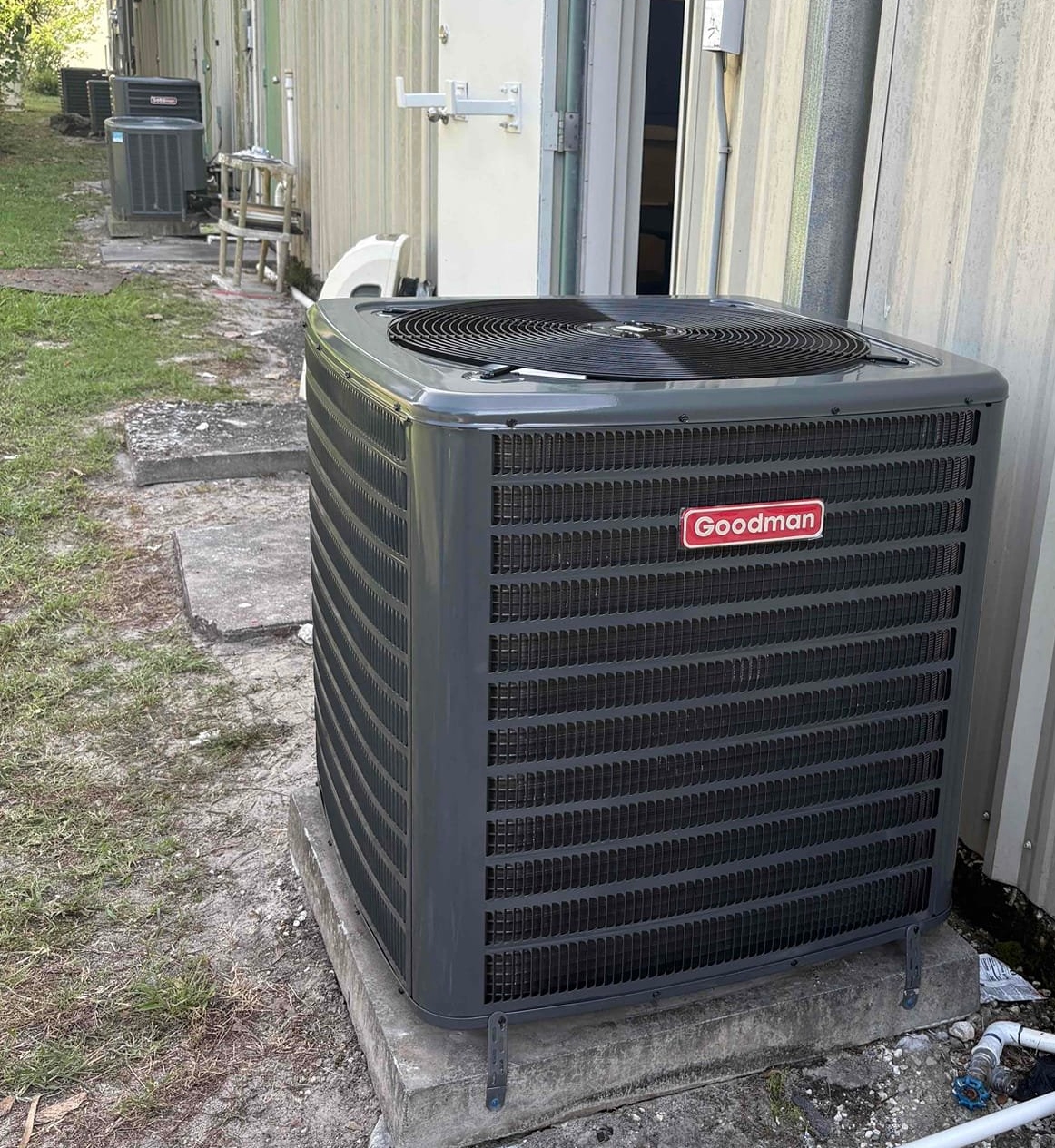


FREE Water Heater
With every whole house repipe purchase. Free brand-new water heater or credit towards a tankless water heater.
.svg)
.svg)
.svg)
.svg)



With every whole house repipe purchase. Free brand-new water heater or credit towards a tankless water heater.
.svg)
.svg)
.svg)
.svg)

Recognizing early warning signs and understanding commercial HVAC repair costs can save businesses thousands of dollars and prevent major system failures.
When commercial HVAC systems break down, businesses face disrupted operations, uncomfortable employees, and costly emergency repairs. These complex heating and cooling systems keep office buildings, restaurants, and industrial facilities running smoothly every day.
Many companies wait until their HVAC system completely stops working before calling for help. This approach often leads to more expensive repairs and longer downtime.
Smart business owners learn to spot problems early and work with qualified repair companies to keep their systems running efficiently. In this article, you’ll learn how to plan commercial HVAC repair to minimize downtime, control costs, and protect occupant comfort.
Here’s what you need to know:
Keep reading! Understanding what causes breakdowns and how to choose the right repair service protects both employees and bottom-line profits.
Commercial HVAC systems often show warning signs before they break down completely. Strange sounds, higher energy costs, and uneven temperatures throughout the building are clear signals that emergency HVAC service may be needed soon.
Grinding, squealing, or banging sounds from HVAC equipment indicate serious mechanical problems. These noises often mean bearings are worn out, belts are loose, or fan blades are damaged.
Inconsistent airflow creates hot and cold spots throughout the building. Some areas may feel stuffy while others get too much air.
Common airflow problems include:
Motor problems cause many of these issues. When motors work harder than normal, they make loud noises and use more energy.
Clogged filters also reduce airflow significantly. However, if changing filters does not fix the problem, the system likely needs professional repair.
According to the U.S. Department of Energy, replacing a dirty, clogged HVAC filter with a clean one can cut air-conditioner energy use by about 5–15%, easing strain and costs.
Energy bills that jump 15-20% without explanation often mean the HVAC system is working harder than it should. Worn parts force the system to run longer to maintain comfortable temperatures.
Key warning signs in energy usage:
Refrigerant leaks make commercial air conditioning repair necessary quickly. Low refrigerant forces the system to work much harder and increases energy costs dramatically.
Dirty coils also waste energy. When coils get covered with dirt and debris, the system cannot transfer heat properly.
Researchers at the National Renewable Energy Laboratory report that evaporator-coil fouling reduces airflow, can lead to coil freeze-up, and may damage compressors if not corrected, underscoring routine coil cleaning.
Failing thermostats can cause energy waste too. They may not read temperatures correctly, making the system run when it should be off.
Hot and cold zones throughout the building show that the HVAC system cannot distribute air evenly. This problem often gets worse over time without proper repairs.
Ductwork problems cause many temperature issues. Leaky ducts let conditioned air escape before it reaches its destination.
Temperature problems to watch for:
Failing dampers also create temperature imbalances. These parts control airflow to different building zones. When they stick or break, some areas get too much air while others get none.
Compressor problems affect the entire cooling system. A failing compressor cannot provide consistent cooling, leading to temperature problems throughout the building.
Commercial HVAC systems face several recurring problems that can shut down operations. The most frequent issues stem from poor maintenance practices, electrical component failures, and airflow restrictions that force systems to work harder than designed.
Dirty evaporator and condenser coils create major problems for commercial HVAC systems. When coils collect dust and debris, they cannot transfer heat effectively.
This forces the system to run longer cycles and use more energy. The compressor works harder to maintain temperatures, which leads to premature wear.
Clogged air filters block airflow throughout the system. Restricted airflow causes the evaporator coils to freeze up during cooling mode.
Common signs of dirty coils and filters:
Frozen coils require complete system shutdown for thawing. This can take several hours and often happens during peak business hours.
Regular filter changes prevent most airflow problems. Coil cleaning should happen at least twice per year in most commercial settings.
Electrical problems cause sudden system shutdowns in commercial buildings. High power demands during peak hours can trip breakers or damage circuit boards.
Complex wiring in large systems creates multiple failure points. Loose connections generate heat and can cause fires or component damage.
Common electrical failures include:
Temperature and pressure sensors control system operation. When sensors fail, the system cannot read conditions properly.
A broken temperature sensor might cause the system to run constantly. Faulty pressure sensors can trigger false alarms that shut down equipment.
Electrical issues require immediate attention from qualified technicians. Attempting DIY repairs on commercial electrical systems violates safety codes in most areas.
OSHA’s lockout/tagout guidance requires de-energizing equipment and verifying power is off before servicing to prevent shock and injury, critical when accessing commercial HVAC electrical panels or components.
Skipped maintenance allows small problems to become major failures. A loose belt can snap and damage other components if not tightened during routine service.
Regular maintenance includes checking refrigerant levels, testing electrical connections, and replacing worn parts. These tasks prevent most system breakdowns.
Maintenance tasks that prevent failures:
Without maintenance, commercial systems typically fail within 5-7 years instead of lasting 15-20 years. Emergency repairs cost 3-5 times more than scheduled maintenance.
HVAC system troubleshooting becomes more complex when multiple components fail together. A clogged filter can cause coil freezing, which damages the compressor and creates electrical faults.
Preventive maintenance contracts help businesses avoid these cascading failures. Trained technicians spot problems before they cause system shutdowns.
Putting off HVAC repairs creates mounting costs that go far beyond the original repair price. Business owners face lost productivity, wasted energy, and equipment damage that can force expensive replacements.
When HVAC systems fail, indoor temperatures become hard to control. Employees work slower in hot or cold conditions. Studies show worker productivity drops by 6-9% for every degree above 77°F.
Customer comfort matters too. Shoppers leave stores faster when temperatures feel uncomfortable. Restaurants lose diners when dining rooms get too warm.
Common productivity impacts include:
Some businesses must close completely during system failures. A restaurant cannot serve food safely without proper air conditioning. Office workers may need to leave early when heating fails in winter.
Lost revenue adds up quickly. A retail store losing $5,000 per day during a three-day repair period faces $15,000 in missed sales.
Broken HVAC components force systems to work harder. A failing compressor uses 20-30% more electricity to cool the same space. Dirty coils reduce efficiency by up to 40%.
Small problems create bigger energy waste over time. A refrigerant leak makes the system run longer cycles. Worn belts cause motors to strain and use extra power.
Energy waste from delayed repairs:
Monthly utility bills show the damage. A business spending $2,000 per month on HVAC energy might pay $2,600 with efficiency problems. That extra $600 monthly equals $7,200 yearly in wasted costs.
Major repairs sometimes cost more than installing new equipment. A 15-year-old system needing a $8,000 compressor replacement might be better replaced entirely.
Replacement makes sense when:
Emergency repairs cost 3-5 times more than planned maintenance. Weekend and holiday service calls include premium labor rates. Rush parts orders add shipping fees.
A $500 belt replacement becomes $1,500 during an emergency call. The same repair done during regular maintenance costs much less. Businesses save money by fixing problems before they cause breakdowns.
The success of your commercial HVAC repair depends on finding a contractor with proper credentials and extensive commercial experience. Service agreements provide long-term value that often outweighs choosing the cheapest repair option.
Licensing and certifications form the foundation of any trustworthy HVAC contractor. Property managers should verify that contractors hold current state licenses and EPA certifications for refrigerant handling.
Insurance coverage protects businesses from liability during repairs. Contractors should carry both general liability and workers' compensation insurance with coverage amounts appropriate for commercial projects.
Response time commitments matter for business operations. Reliable contractors offer emergency services with guaranteed response times, typically within 2-4 hours for urgent issues.
Equipment expertise varies significantly between contractors. The best repair companies work with multiple HVAC brands and stay current on new technology through ongoing training programs.
Local reputation provides insight into service quality. Property managers can check Better Business Bureau ratings, online reviews, and request references from similar commercial properties in their area.
Commercial systems complexity exceeds residential HVAC in every aspect. These systems require specialized knowledge of multi-zone controls, variable air volume systems, and industrial HVAC maintenance protocols.
Building code requirements for commercial properties differ significantly from residential standards. Experienced contractors understand ventilation requirements, safety codes, and permit processes for commercial buildings.
Downtime costs from poor repairs can exceed thousands of dollars per hour in lost productivity. Contractors with commercial experience complete repairs faster and with fewer return visits.
System sizing mistakes prove costly in commercial settings. Experienced contractors properly calculate load requirements and understand how building usage patterns affect HVAC performance.
Warranty protection often depends on using qualified contractors. Many commercial equipment manufacturers require certified technicians to maintain warranty coverage on expensive industrial systems.
Preventive maintenance schedules through service agreements catch problems before they cause system failures. Regular inspections typically extend equipment life by 30-50% compared to reactive maintenance approaches.
Priority service comes with most maintenance agreements. Customers with service contracts receive faster response times and scheduling priority during peak seasons when repair demand increases.
Cost predictability helps businesses budget for HVAC expenses. Service agreements spread maintenance costs throughout the year and often include discounts on emergency repairs and replacement parts.
Filter replacement programs maintain system efficiency and indoor air quality. Contractors track filter schedules and provide replacements as part of comprehensive maintenance agreements.
Performance monitoring identifies efficiency problems early. Regular maintenance visits include system performance checks that can reduce energy costs by 15-20% through proper calibration and cleaning.
Commercial HVAC systems require regular attention to maintain peak performance. Professional repair services help prevent costly breakdowns and extend equipment lifespan.
Business owners should watch for warning signs like unusual noises, poor airflow, or rising utility bills. These issues often indicate the need for professional repair services.
Regular maintenance programs save money over time. They catch small problems before they become major expenses.
Professional technicians have the skills and tools to diagnose complex HVAC issues. They can determine whether a system needs repair or replacement.
Quick response to HVAC problems protects business operations. System failures can disrupt work and affect employee comfort.
Smart business owners invest in preventive maintenance contracts. These agreements provide regular inspections and tune-ups throughout the year.
Commercial HVAC repair keeps buildings comfortable and energy-efficient. Property managers who prioritize system maintenance protect their investment and ensure tenant satisfaction.
The right repair company will offer 24/7 emergency service. They understand that HVAC problems don't wait for convenient times.
Schedule a same-day commercial HVAC diagnostic with Sunshine Services to isolate faults (compressors, VFDs, sensors, or control boards), stabilize temperatures, and restore full capacity with priority repair.